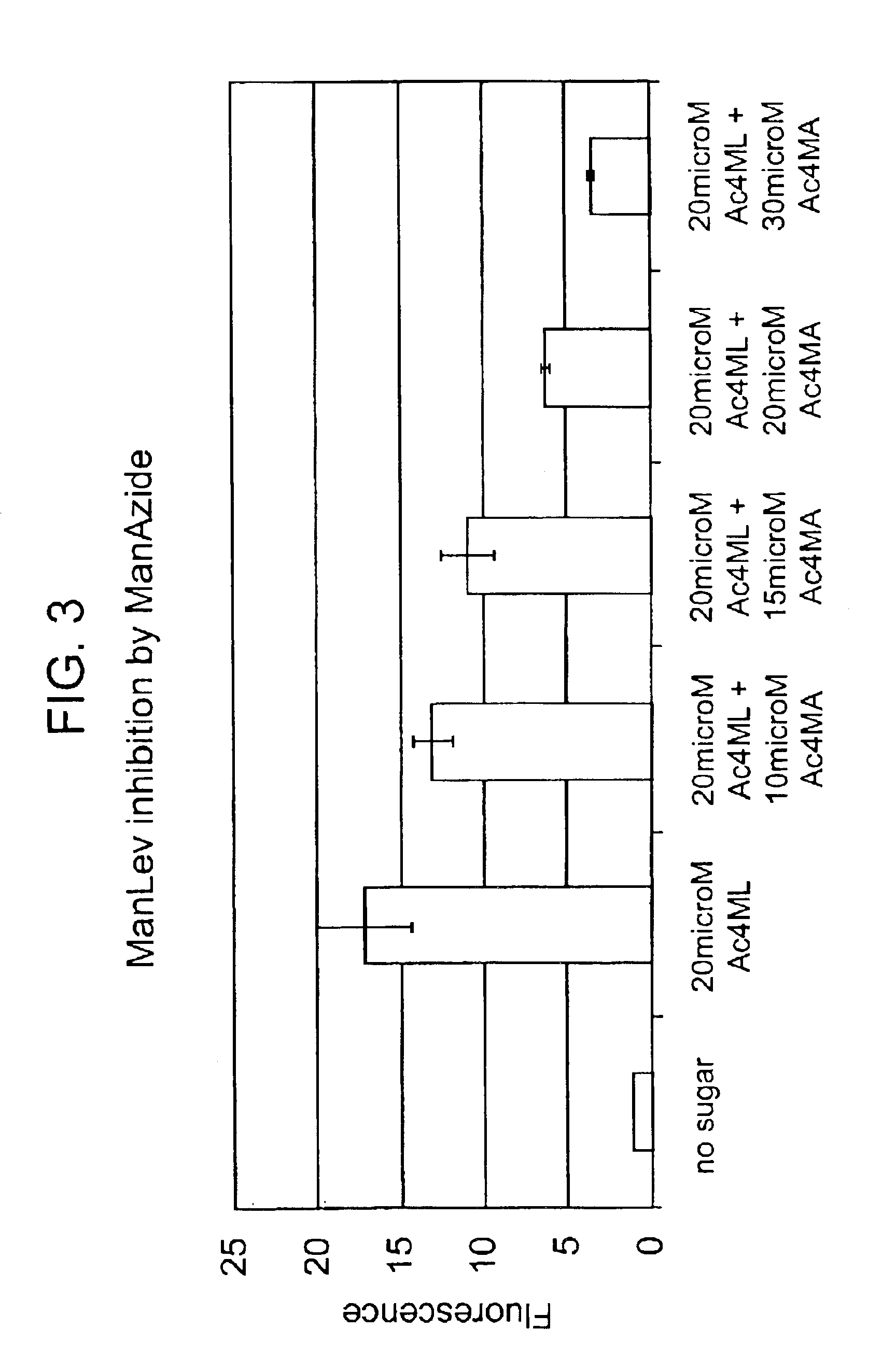Chemoselective ligation
a chemoselective ligation and ketone ligation technology, applied in the field of covalent modification of molecules, can solve the problems of limiting intracellular utility of ketone ligation reactions, preventing the use of most conventional covalent reactions, and all reactions
- Summary
- Abstract
- Description
- Claims
- Application Information
AI Technical Summary
Benefits of technology
Problems solved by technology
Method used
Image
Examples
example 1
Development of an Aqueous Staudinger Ligation and Water Soluble Azide
[0131]Two routes were devised to effect an aqueous Staudinger ligation, each incorporating several of the desired features. The first is shown in route A in Scheme 1. This reaction is known to proceed in high yield in wet ether (0.01% H2O) (Keogh et al. J. Org. Chem. 1986, 51, 2767), however it was unknown whether hydrolysis of the aza-ylide (route B) would begin to compete in conditions approaching 55M H2O.
[0132]To address this issue, the water soluble azide 6 was synthesized according to Scheme 2. Commercially available tetraethylene glycol 5 was reacted with MsCl followed by displacement with NaN3 to form the monoazide 6, which was then subjected to a reaction with a model phosphinite, methyl diphenylphosphinite 7, to afford phosphoramidate 8 (Scheme 2). THF was required as a co-solvent in order to solubilize compound 7, however the reaction continued to proceed with average yields of 91% at 10, 20, 30 and even...
example 2
Synthesis of Phosphine Moiety with Methyl Ester as Covalent Trap for Aza-ylide and Coupling to Carbohydrate Azides
[0133]The disadvantages noted in Example 1 prompted the development of a second method, one that has not been previously reported, for effecting an aqueous Staudinger ligation (Scheme 3). We hypothesized that a methyl ester within the phosphine moiety 9 would provide a covalent trap for the aza-ylide 10. Subsequent rapid hydrolysis of the rearrangement product 11 yields the ligation product 12. Similar to the chemistry utilized by Kent and coworkers for native chemical ligation, this reaction involves a rapid cyclization via a five membered ring transition state, followed by an irreversible step to form the final product.
[0134]This reaction has the advantage of utilizing a more air stable class of phosphines that can be synthesized via a more general route. A model phosphine (13, Scheme 4) was synthesized via a palladium coupling reaction of diphenylphosphine (14) and a...
example 3
Synthesis of Substrate for use in Production of Azides within Cell Surface Sialic Acid Residues
[0137]Having shown that the Staudinger ligation used to form 18 and 19 in Scheme 5 above has the potential to succeed in an aqueous environment, the next step was to synthesize a vehicle for the expression of azides within cell surface sialic acid residues. Azides were chosen as the cell surface coupling partner rather than phosphines due to their inherent stability and also due to size restrictions on the N-acyl substituents of mannosamine imposed by the enzymes of the sialic acid biosynthetic pathway (Jacobs et al. Meth. Enzymol. 1999, 303,:468-79). Two synthetic targets were designed: N-azidoacetylmannosamine 20 and N-azidopropanoylmannosamine 21. These compounds can be synthesized from mannosamine (22) and the corresponding haloacids (see schematic below).
[0138]The zido-acids 23 and 24 were obtained in good yield by nucleophilic displacement of the corresponding bromides 25 and 26 (Sc...
PUM
| Property | Measurement | Unit |
|---|---|---|
| Cell densities | aaaaa | aaaaa |
| volume | aaaaa | aaaaa |
| volume | aaaaa | aaaaa |
Abstract
Description
Claims
Application Information
 Login to View More
Login to View More - R&D
- Intellectual Property
- Life Sciences
- Materials
- Tech Scout
- Unparalleled Data Quality
- Higher Quality Content
- 60% Fewer Hallucinations
Browse by: Latest US Patents, China's latest patents, Technical Efficacy Thesaurus, Application Domain, Technology Topic, Popular Technical Reports.
© 2025 PatSnap. All rights reserved.Legal|Privacy policy|Modern Slavery Act Transparency Statement|Sitemap|About US| Contact US: help@patsnap.com



